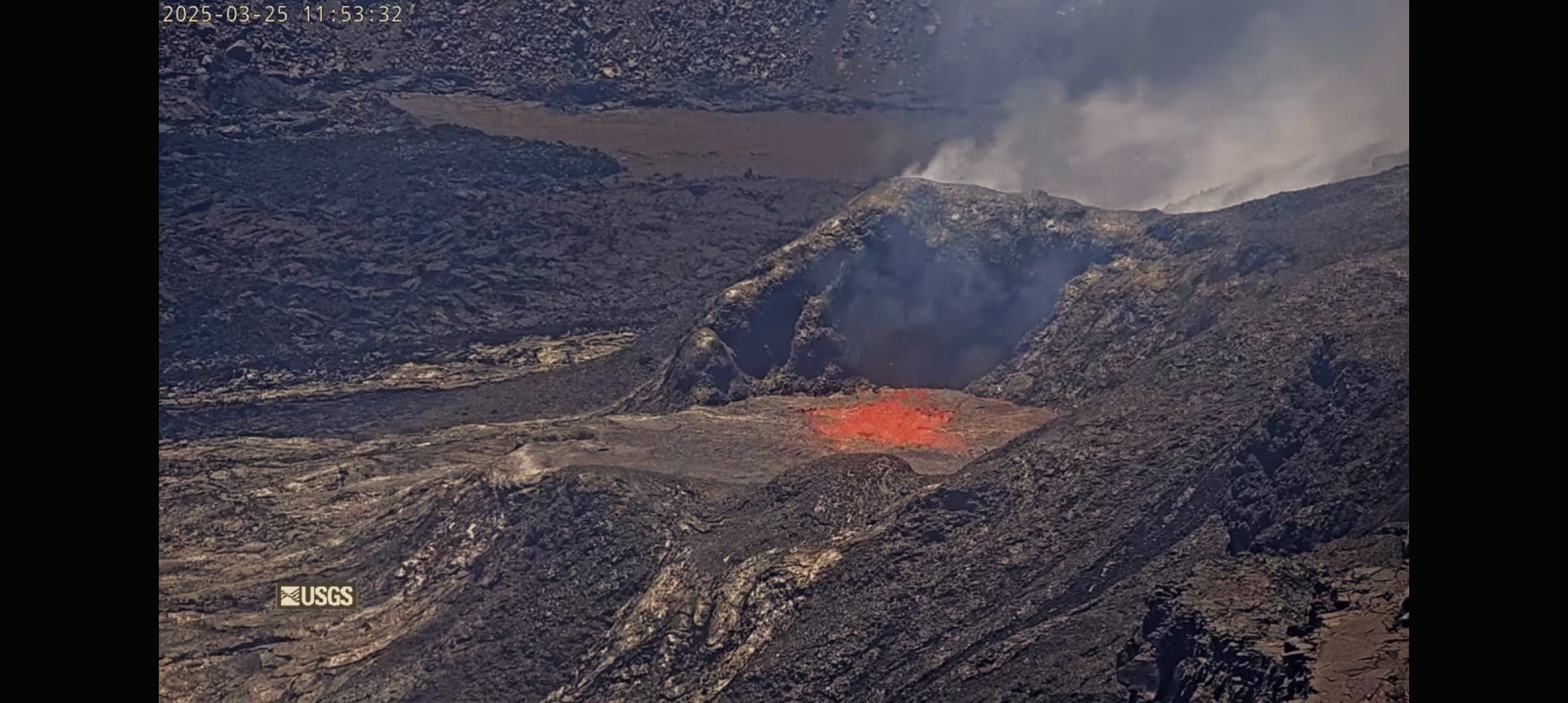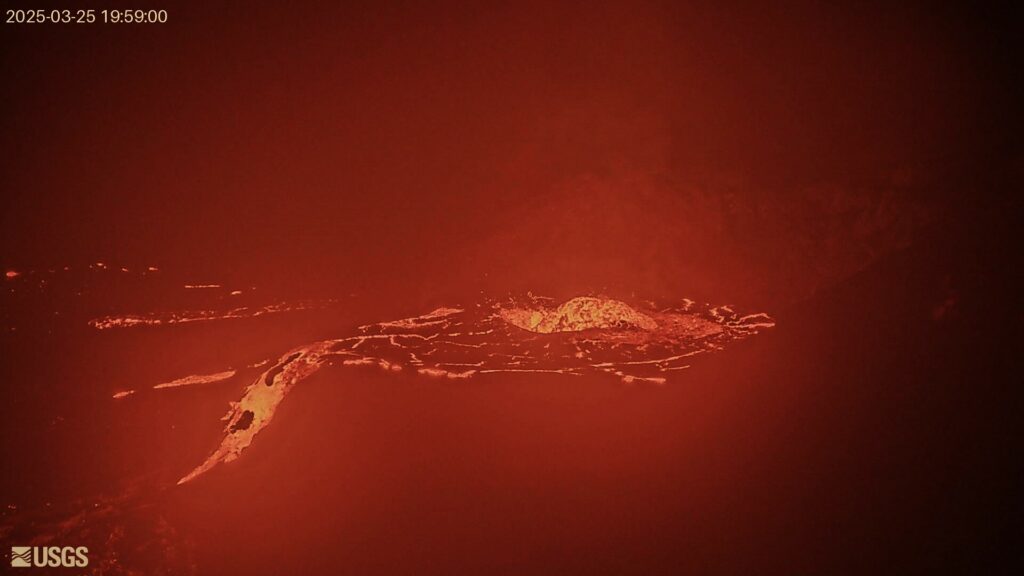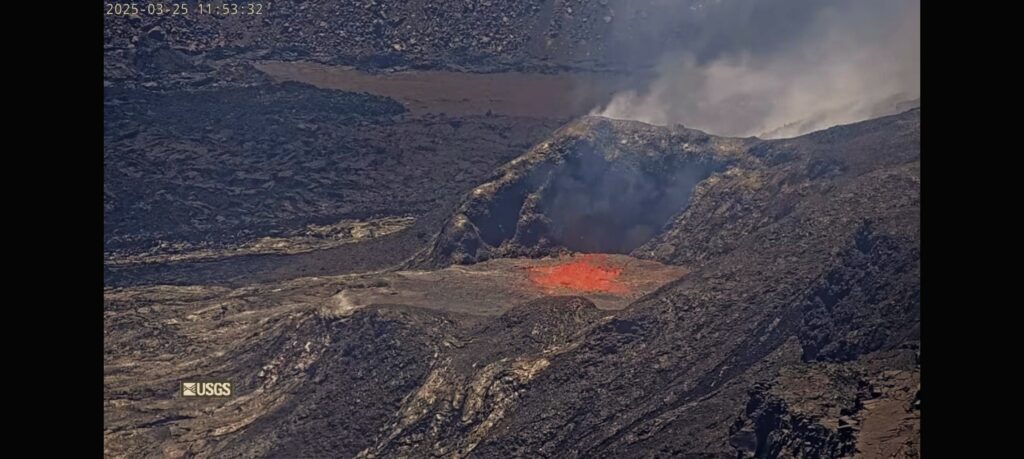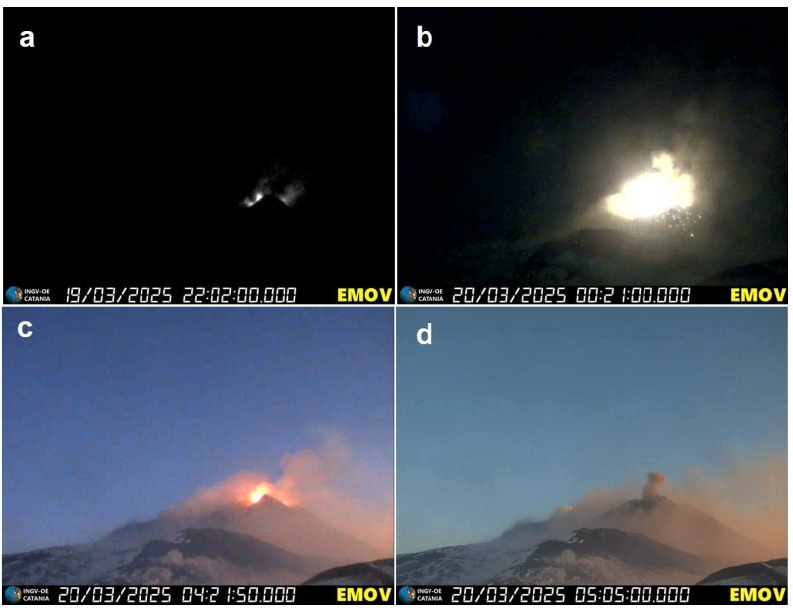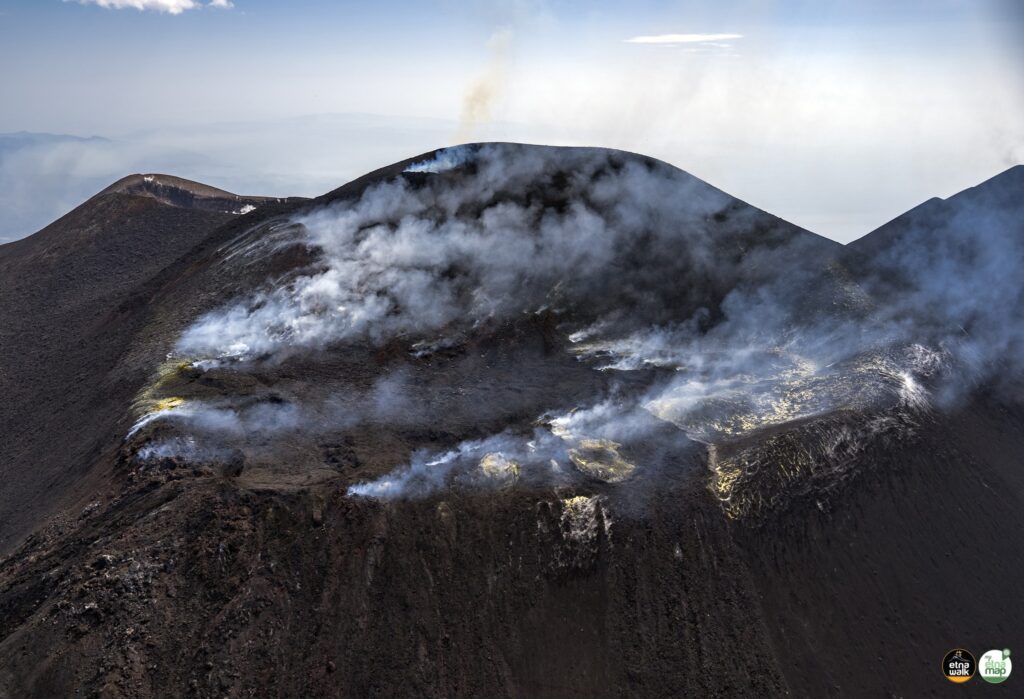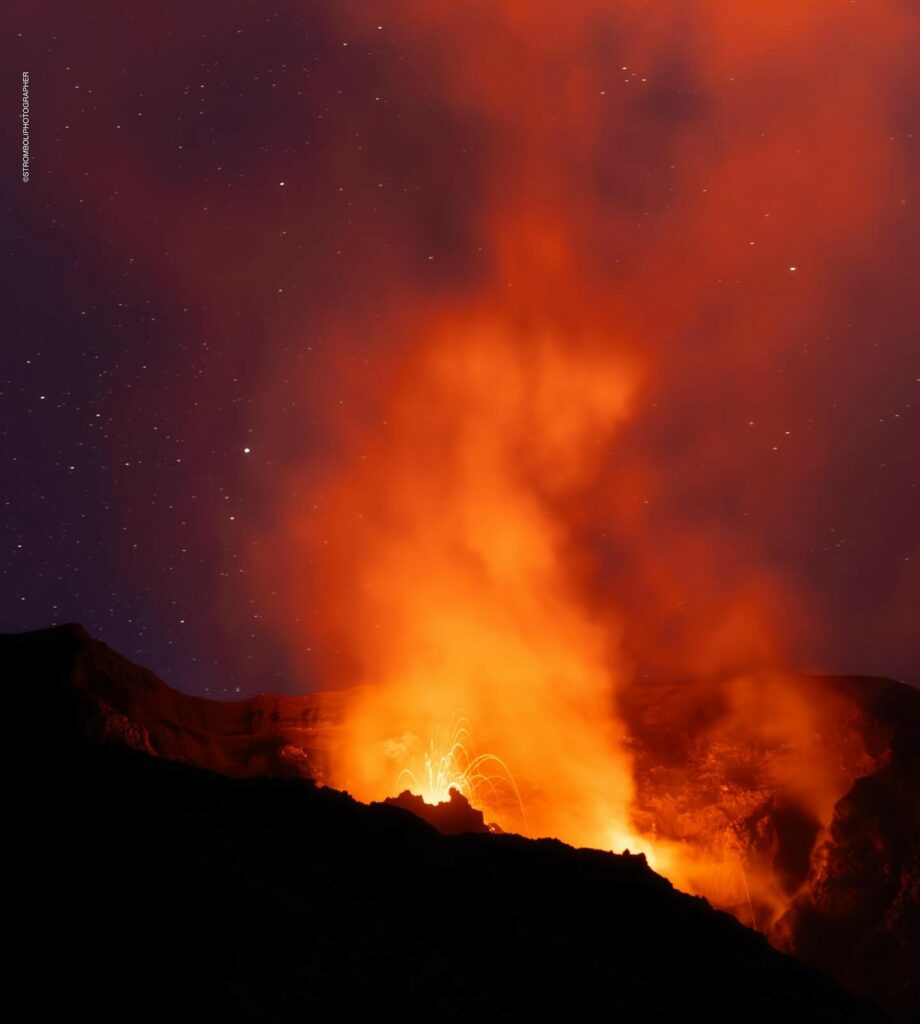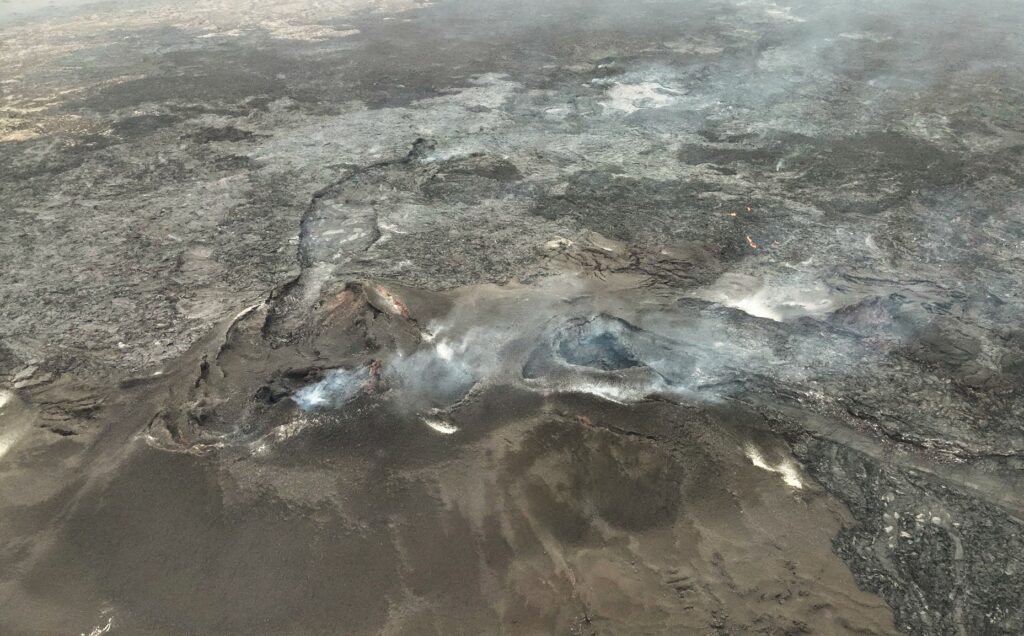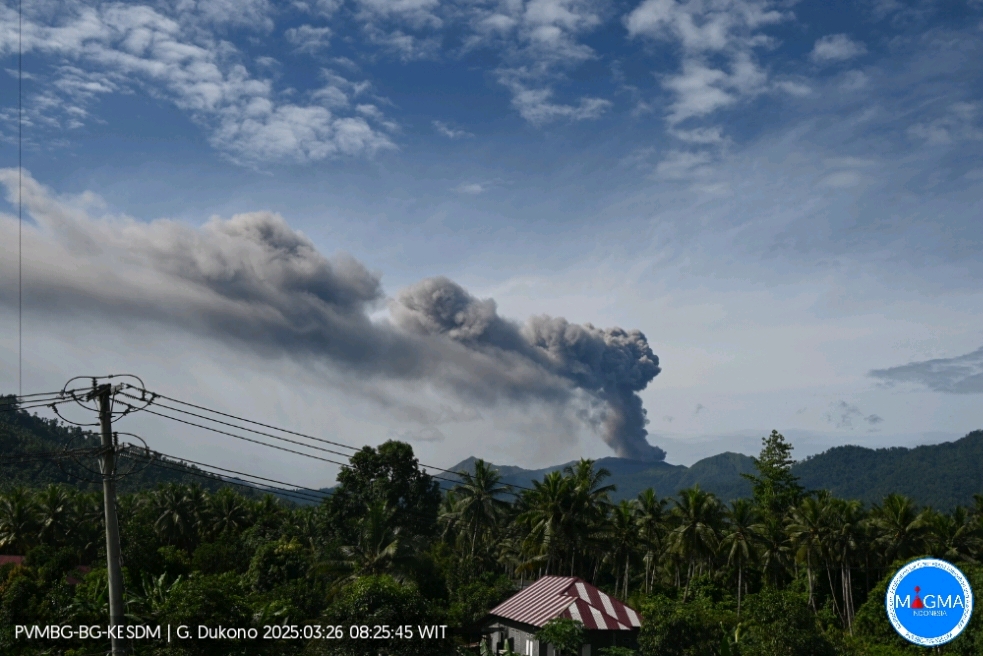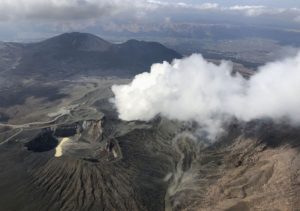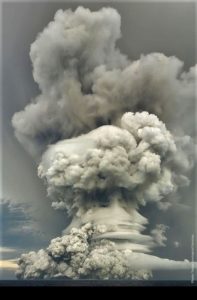March 26 , 2025 .
Hawaii , Kilauea :
Tuesday, March 25, 2025, 2:02 PM HST (Wednesday, March 26, 2025, 00:02 UTC)
19°25’16 » N 155°17’13 » W,
Summit Elevation 4091 ft (1247 m)
Current Volcano Alert Level: WATCH
Current Aviation Color Code: ORANGE
Activity Summary:
Episode 15 of the ongoing Halemaʻumaʻu eruption began at 12:04 p.m. HST on March 25 with the onset of vigorous overflows from the north vent and is continuing cycles of lava rise, fountaining and vigorous overflows, and drainback events. No high fountaining has occurred during this episode as of the time of this update.
Episode 15 was preceded by eight cyclic, small spatter fountains in the north vent that began at approximately 9:27, 9:55, 10:11, 10:29, 10:48, 11:07, 11:27, and 11:45 a.m. HST on March 25 and lasted for 5-10 minutes each. The ninth cycle lasted from 12:04-12:19 p.m. HST and produced vigorous overflows that extended 150 to 300 feet (50-100 meters) into Halemauʻamaʻu crater. Activity increased in activity with subsequent events from at 12:25-12:39, 12:47-13:02,13:08-13:23, 3:29-13:39, and 13:46- 13:58 p.m. HST. These continued to increase in intensity with fountains up to 30-50 feet high (10-15 meters) from the north vent. Around noon, the south vent also became active and is feeding a lava flow out onto the crater floor. Flows from both vents have covered about 5% of the floor of Halemaʻumaʻu crater at this time. High fountaining has not yet begun, but is expected to follow the cyclic fountains and drainbacks as it did during episode 14.
Inflationary tilt reached just over 5 microradians since the end of the last episode recovering more than 100% of the tilt lost from episode 14. Seismic tremor began increasing with cyclic fountains and drainbacks, and tilt at SDH switched from inflation to deflation at about 1 p.m. HST, about the same time lava flows began erupting onto the crater floor.
Emissions of SO2 gas during episodes 13 and 14 have exceeded 40,000 tonnes per day and similar amounts of gas are expected to accompany fountain eruptions during episode 15. Currently winds at the summit are predicted to be weak, which may allow the plume of gas to spread around the summit region of Kīlauea. In addition, visitors to Hawaiʻi Volcanoes National Park and residents of adjacent towns may be exposed to Peleʻs hair and other small fragments of volcanic glass being carried in the plume.
Each episode of Halemaʻumaʻu lava fountaining since December 23, 2024, has continued for 13 hours to 8 days, and episodes have been separated by pauses in eruptive activity lasting less than 24 hours to 12 days.
No changes have been detected in the East Rift Zone or Southwest Rift Zone. HVO continues to closely monitor Kīlauea and will issue an eruption update tomorrow morning unless there are significant changes before then.
Kīlauea Volcano Alert Level/Aviation Color Code remain at WATCH/ORANGE. All current and recent activity is within Hawaiʻi Volcanoes National Park.
Source et photo : HVO.
Italy / Sicily , Etna :
WEEKLY BULLETIN, from March 17, 2025 to March 23, 2025. (Issue date March 25, 2025)
ACTIVITY SUMMARY
Based on monitoring data, the following are highlighted:
1) VOLCANOLOGICAL OBSERVATIONS: Variable-rate degassing activity from the summit craters. Strombolian activity and lava overflow at the Southeast Crater.
2) SEISMOLOGICAL: Absence of seismic activity due to fracturing with Ml>=2.0. Tremor amplitude at a predominantly medium-low level.
3) INFRASOUND: Mainly weak infrasound activity, with sources located in the Southeast Crater area. 4) GROUND DEFORMATIONS: No significant variations are reported in the time series from tilt and GNSS stations.
5) GEOCHEMISTRY: SO2 fluxes at a medium level.
Soil CO2 fluxes (EtnaGas Network) are decreasing towards low values.
Partial pressure of dissolved CO2 in the aquifer (Ponteferro). For technical reasons, no update is available.
Isotope ratio of peripheral sites: Latest data (11/03/2025) show medium-high values.
6) SATELLITE OBSERVATIONS: Thermal activity observed by satellite in the summit area was generally low-level, with some isolated high-level thermal anomalies corresponding to the eruptive activity of the Southeast Crater on March 20, 2025.
Strombolian activity at the Southeast Crater on March 19 and 20, recorded by the Montagnola Visible Camera (EMOV). a) Initial phase of intracrater activity; b) Intensification of activity, with deposition of coarse material on the cone walls; c) Decrease in the intensity of Strombolian explosions; d) Modest ash emissions from the final phases of eruptive activity.
VOLCANOLOGICAL OBSERVATIONS
Monitoring of volcanic activity at Etna was carried out by analyzing images from the INGV (Osservatorio Etneo) surveillance camera network and by an inspection of the summit area on March 21. Observations of activity within the summit craters were discontinuous due to the presence of extensive cloud cover.
During the period studied, Etna’s activity was characterized by continuous degassing of varying intensity and regime in the summit craters and by eruptive activity in the Southeast Crater.
On March 19, starting at 21:25 UTC, Strombolian activity began from various vents in the Southeast Crater. In the initial phases, the explosions reached a height of a few tens of meters above the crater, with coarse material falling back into it. Over the following hours, and until approximately 01:30 UTC on March 20, the activity gradually increased in intensity and explosion frequency, producing coarse material that was also deposited on the flanks of the Southeast Crater cone. Subsequently, the activity gradually decreased and, at 04:45 UTC on 20 March, the explosions were no longer visible on the camera images, while for about an hour, a modest ash emission continued, dispersing rapidly in the summit area.
On March 24, following a slight improvement in weather conditions in the summit area, Strombolian activity was observed at the Southeast Crater, starting at approximately 10:25 UTC. The presence of thick cloud cover made it difficult to estimate the intensity and frequency of the explosions. At approximately 11:35 UTC, for a short period, a small lava flow was observed overflowing from the rim of the Southeast Crater and flowing down the southern flank of the cone. No ash fall was reported on the towns in the northeast sector of the volcano where, according to forecast models, any eruptive clouds should have dispersed. Despite the thick cloud cover, thermal camera images allowed us to observe that intra-crater Strombolian activity in the Southeast Crater continued until about 20:00 UTC on March 24 and that the lava overflow appeared to be cooling at the same time..
Source : INGV
Photos : INGV , Etna Walk/ Giuseppe Distefano ( 03/08/2024)
Italy , Stromboli :
WEEKLY BULLETIN, from March 17, 2025 to March 23, 2025 (issue date March 25, 2025).
ACTIVITY STATUS SUMMARY
Based on monitoring data, the following is highlighted:
1) VOLCANOLOGICAL OBSERVATIONS: During this period, ordinary explosive eruptive activity was observed. The total hourly frequency ranged from low (4 events/h) to medium (11 events/h). The intensity of the explosions was low to medium in the North and Central-South crater areas.
2) SEISMOLOGICAL: The monitored seismic parameters show no significant variations. 3) GROUND DEFORMATIONS: No significant variations were reported.
4) GEOCHEMISTRY: SO2 flux at an average level.
The soil CO2 flux in the Pizzo area (STR02) remains at high to very high values.
CO2/SO2 ratio in the plume (Stromboli Plume Network). Latest data (March 23) show high values.
Dissolved helium isotope ratio (R/Ra) in the thermal aquifer: Data from March 4, 2025, show high values.
Soil CO2 flux in the San Bartolo area is at average values.
Soil CO2 flux in the Scari area is at average values.
5) SATELLITE OBSERVATIONS: Thermal activity observed by satellite in the summit area was generally low.
VOLCANOLOGICAL OBSERVATIONS
During the observation period, Stromboli’s eruptive activity was characterized by analyzing images recorded by INGV-OE surveillance cameras located at an altitude of 190 m (SCT-SCV) and at Punta dei Corvi (SPCT). Explosive activity was produced mainly by four eruptive vents located in the northern area of the crater and by at least two vents located in the central-southern area.
Observations of explosive activity captured by surveillance cameras
In the North (N) crater area, four active vents were observed, producing explosive activity of low intensity (less than 80 m in height) and sometimes of medium intensity (less than 150 m in height). The ejected products consisted mainly of coarse materials (bombs and lapilli). The average explosion frequency ranged between 3 and 7 events/h. In the South-Central (SC) area, explosive activity was produced by at least two vents; the explosions were of low and medium intensity, projecting fine materials (ash) sometimes mixed with coarse materials (lapilli and bombs). The average frequency of explosions varied between 1 and 4 events/h.
Source : INGV
Photo : Stromboli stati d’animo / SebastianO Cannavo.
Iceland , Reykjanes Peninsula :
Eruption at the Sundhnúkur crater row remains likely
Magma volume beneath Svartsengi is at its highest since the eruption series began in December 2023
Updated 25 March at 15:00 UTC
Magma accumulation continues, but the rate of uplift has slowed in recent weeks
The most likely scenario is that this period of magma buildup will end with a magma intrusion and/or an eruption, likely emerging first in the area between Sundhnúkur and Stóra-Skógfell
Seismic activity has gradually increased in recent weeks, indicating that pressure at the eruption site is increasing
An eruption could begin with very little warning
The hazard assessment remains unchanged
GPS deformation data shows that magma continues to accumulate beneath Svartsengi, although the pace of land uplift has slightly decreased in recent weeks. Despite the slower uplift, experts still consider it likely that a magma intrusion and/or eruption will occur along the Sundhnúkur crater row.
The potential size of the eruption depends on how much magma is released from the magma chamber when the eruption begins. The volume of magma has never been greater since the eruption sequence at the Sundhnúkur crater row began in December 2023, meaning the next eruption could be larger than previous ones in terms of volume. It is most likely that magma will first surface in the area between Sundhnúkur and Stóra-Skógfell, a pattern seen in six of the seven eruptions since volcanic activity resumed in late 2023. The exception was the eruption in January 2024, when magma first emerged just south of Hagafell.
Seismic activity has been slowly increasing in recent weeks. Repeated events along the Sundhnúkur crater row, where magma intrusions and eruptive fissures have formed, have reduced stress in the crust over time. As a result, fewer and smaller earthquakes are detected in the lead-up to eruptions, compared to earlier in the eruption sequence. Warning time before an eruption is expected to remain very short; in the last two eruptions, only 30–40 minutes passed from the first signs of increased seismicity to the actual onset of eruption. Indicators that magma is moving toward the surface include intense earthquake swarms on the Sundhnúkur crater row, pressure changes in HS Orka’s boreholes at Svartsengi, deformation observed in fiber-optic cables, and surface changes captured by real-time GPS measurements.
Source : IMO
Photo : Stóra-Skógfel , Protection civile/Björn Oddsson ,
Indonesia , Dukono :
An eruption of Mount Dukono occurred on Wednesday, March 26, 2025, at 09:23 WIT with an observed ash column height of ± 1100 m above the peak (± 2187 m above sea level). The ash column was observed to be gray in color with a thick intensity, oriented toward the northeast and east. At the time of writing, the eruption was still ongoing.
VOLCANO OBSERVATORY NOTICE FOR AVIATION – VONA
Issued : March 26 ,2025
Volcano : Dukono (268010)
Current Aviation Colour Code : ORANGE
Previous Aviation Colour Code : orange
Source : Dukono Volcano Observatory
Notice Number : 2025DUK042
Volcano Location : N 01 deg 41 min 35 sec E 127 deg 53 min 38 sec
Area : North Maluku, Indonesia
Summit Elevation : 3478 FT (1087 M)
Volcanic Activity Summary :
Eruption with volcanic ash cloud at 00h23 UTC (09h23 local).
Volcanic Cloud Height :
Best estimate of ash-cloud top is around 6998 FT (2187 M) above sea level or 3520 FT (1100 M) above summit. May be higher than what can be observed clearly. Source of height data: ground observer.
Other Volcanic Cloud Information :
Ash cloud moving from northeast to east. Volcanic ash is observed to be gray. The intensity of volcanic ash is observed to be thick.
Remarks :
Eruption recorded on seismogram with maximum amplitude 34 mm and maximum duration 58.67 second. Tremor recorded on seismogram with maximum amplitude 3 mm.
Source et photo : Magma Indonésie

